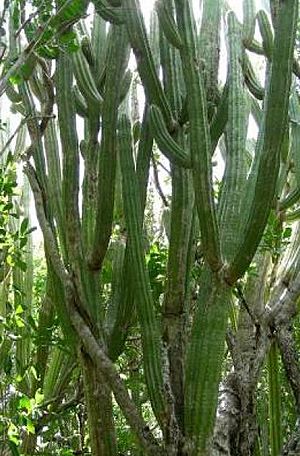Key tree-cactus facts for kids
Quick facts for kids Pilosocereus robinii |
|
|---|---|
 |
|
| Conservation status | |
| Scientific classification | |
| Kingdom: | |
| (unranked): | |
| (unranked): | |
| (unranked): | |
| Order: | |
| Family: | |
| Genus: |
Pilosocereus
|
| Species: |
P. robinii
|
| Binomial name | |
| Pilosocereus robinii (Lem.) Byles & G.D.Rowley
|
|
| Synonyms | |
|
Cephalocereus deeringii Small |
|
The Key tree-cactus (scientific name: Pilosocereus robinii) is a special type of cactus. You can find it naturally growing in the Florida Keys in the United States. It also lives in parts of Western Cuba and the Northern Bahamas. This cactus is very rare and is in danger because its home is disappearing. It's even listed as an endangered species in the United States, meaning it needs protection.
Contents
What Does It Look Like?
The Key tree-cactus is a very large tree-like cactus. It grows straight up and often has many branches that spread out. This cactus can grow as tall as 10 m (33 ft), which is about the height of a three-story building!
Its stem is green, and when it's young, it might have a blue tint. The stem has 9 to 13 ridges, like ribs. Small bumps called areoles cover these ridges. These areoles have long or short hairs and can hold up to 31 spines each. But don't worry, these spines are quite small, usually less than a centimeter long.
Flowers and Scent
The Key tree-cactus has bell-shaped flowers that are about 5–6 cm (2.0–2.4 in) long. The outer parts of the flower are greenish with brown stripes. The inner parts are white.
These flowers have a unique smell, a bit like garlic! They open only at night and contain a sweet liquid called nectar. This nectar is a tasty treat for night-time visitors.
Where Does It Live?
This cactus grows in special places called upland tropical hardwood hammocks. These are forests that grow on limestone or coral rock. You might also find it growing on bare coral rock or just above the high tide mark near the coast.
Threats to Its Home
The Key tree-cactus faces many dangers. One big threat is the destruction of its habitat. As people build more homes and businesses, the cactus's natural areas are lost. For example, many cacti on the Upper and Lower Matecumbe Keys have disappeared due to new buildings. This development also breaks up the cactus's habitat into smaller, disconnected pieces.
Storm surges (when sea levels rise during storms) and rising sea levels can also flood the cactus's coastal home. This can make the water too salty for the cactus to survive.
Hurricanes and the Cactus
Hurricanes are another threat. Strong winds can break the cactus's branches or knock down taller trees, which can hurt the cactus. However, sometimes hurricanes can actually help! When taller trees fall, it can open up the forest canopy. This lets more sunlight reach the cactus, which it needs to grow.
As of 2009, there were only seven known groups of this plant left in Florida. They are found on just four of the many Florida Keys. This shows how rare and important it is to protect this unique cactus.


